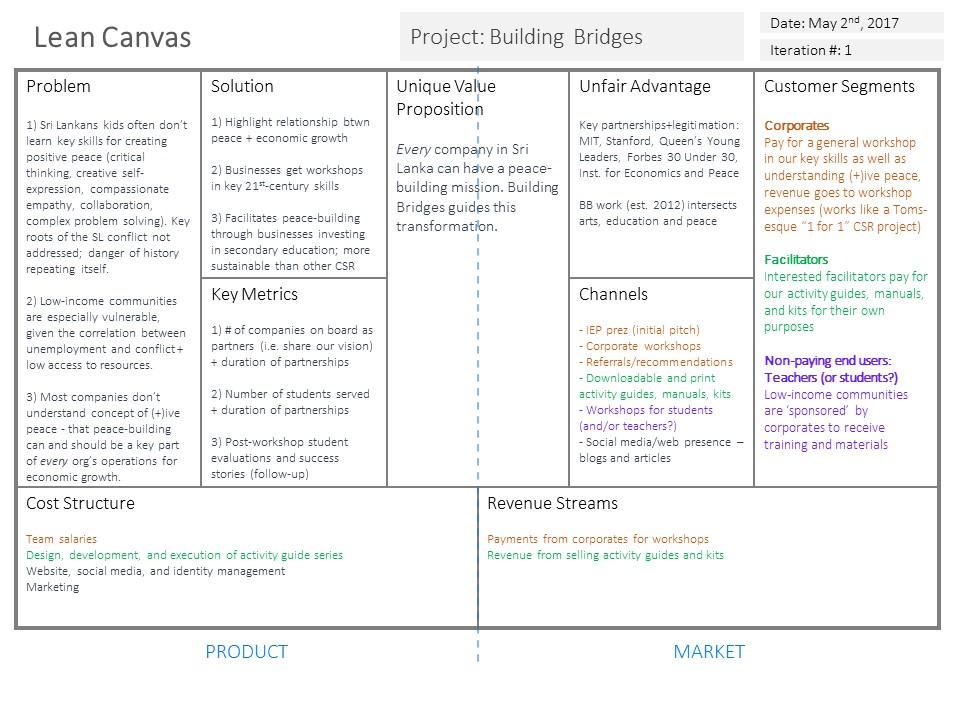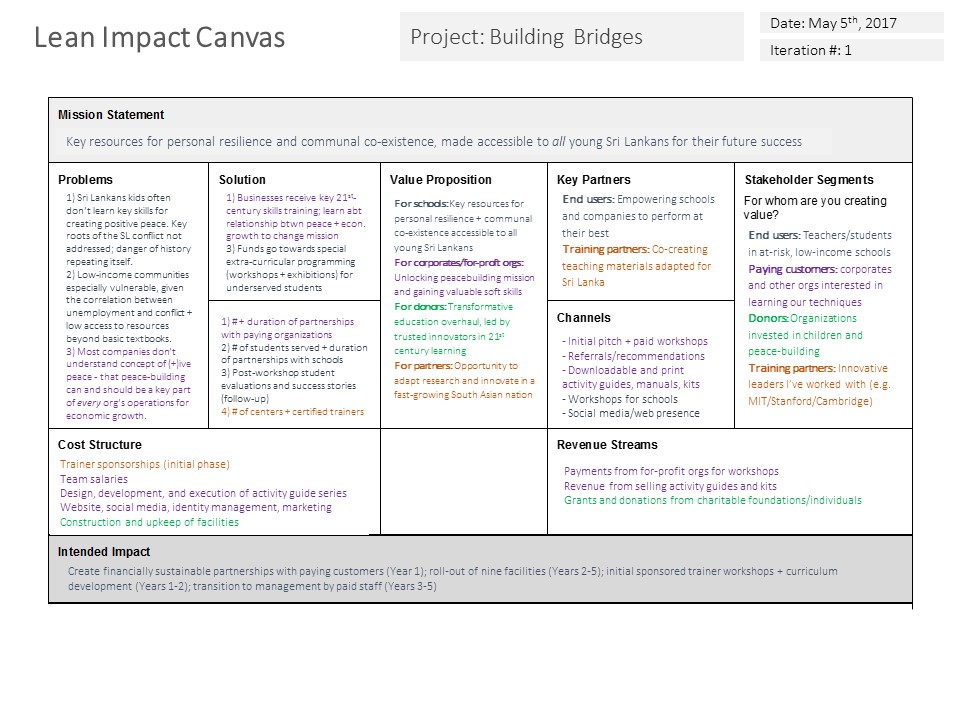Last week, we discussed some challenges around the lean canvas – from clear descriptions, to unique value propositions vs. solutions, to the different between a for-profit business idea and its form(s) as an impact venture. We also started assessing the risks inherent in our ideas.
Thinking in this way is new to me, and doesn’t come easily. To stretch my muscles, I tried to envision Building Bridges as a series of different ventures and assess the risks inherent in each (I’d love to hear feedback in the comments!).
*
Building Bridges right now is a volunteer-driven initiative using the arts – theatre, visual arts, creative storytelling – to foster self-expression and sustained dialogue between Sri Lanka’s diverse youth. We depend on grants for our work, all of which goes towards materials, transport, and accommodation during our rural programming, Visit themonstercycle.com to learn more.
I’d like to change this for several reasons. Firstly, I believe artists and arts educators deserve to be paid. Secondly, not having to scramble for money all the time gives me space to focus on other important aspects of the organization. Thirdly, we all have other jobs, so this is an excellent opportunity to innovate without jeopardising anyone’s job security (while testing the kinds of work I hope to do in future).
Our greatest successes include long-term programmes that have built trust in three key at-risk communities, as well as recognition through the Queen’s Young Leaders Award and Forbes 30 Under 30.
Our greatest challenges are around financial stability, monitoring/evaluation, and scaling our bespoke programmes.
So! Here are my ideas around some potential futures for Building Bridges:
For-profit enterprise (see PDF here)
Comments: I imagine this as a benefit corporation (although the model doesn’t exist yet in Sri Lanka). I would use my training as a Global Peace Index Ambassador to create conversation around the connection between building key soft skills and peace-building, and encouraging for-profit organizations to re-envision their mission through an endeavour that benefits both company employees and under-served communities.
It might strengthen those links through some form of internship or apprenticeship, but this doesn’t quite fit with our peace-building mission (or does it?). One benefit is that, with enough customers, it’s possible to work small – for just one person to do X number of corporate trainings during the week and to run an after-school programme in the evenings (i.e. not worry about the training-teachers part of the model, at least at first).
Risks: The corporate payment structure for workshops doesn’t address the issue of building a team of skilled facilitators. This new structure also works best when it benefits teachers rather than the students, but in the past, we’ve found that schools are more welcoming of after-school programs for students who wouldn’t otherwise have them (it gives the teachers a break!). It’s hard to know if teachers want further training, or even whether willing but resource-strapped teachers will be able to make their training actionable – so I’m running a dedicated pilot workshop series with teachers this summer. It also requires a significant investment of time away from what we want to do (work with low-income kids) and what we would do most (do corporate workshops) to make that happen.
Impact Partnership (see PDF here)
Comments: This version focuses on scale (potentially impacting all Sri Lankan children, who should technically all have access to government-issued text books) as a deliberate challenge to our current model, which works with around 100-200 students over a year, mostly because this kind of scale is hard to control, risks the most dilution, and makes me thoroughly uncomfortable. I feel least equipped for this version, although I could definitely manage gaining legitimacy through a design thinking training partnership with educators I’ve worked with through the Queen’s Young Leaders Award programme, or from MIT and Stanford, if I wrangled sponsorship.
Risks: It veers more into the realm of general curriculum development, and seems to entail policy shifts – pushing for conflict resolution training to be a mandatory part of teacher training, for example. It also requires more understanding than I currently have around a number of factors, such as processes involved in curriculum development and teacher training courses and certification in Sri Lanka. Finally, it’s hard to measure whether the text books are used as intended (although dedicated teacher training and school awards might help spur innovation). Legitimization around new teaching methods is also a stumbling block – does it count if the education evangelist is not ‘MIT’ but an MIT grad, for example? Also, if we pull in international experts, a language barrier is inevitable. Finally, I’ve found our textbooks to contain some ideologically iffy content in the past – I am concerned that there might be a lot of compromise in how content is written and presented.
Nonprofit Foundation (see PDF here)
Comments: This version envisions an independent training center and exhibition space (or rather, several of these facilities), and has the potential to be the most independent in terms of curriculum, and relies on both grants and course fees for its operations. In many ways, it’s a mash-up of the previous models, but requires more brick-and-mortar facilities.
Risks: It’s super ambitious, and requires having partnerships with elite organisations and individuals before we can sustainably engage with our low-income, at-risk communities. Building and maintaining facilities are expensive undertakings. Some of the other risks from previous models also apply, such as challenges regarding legitimisation, language barriers, and time taken away from our most needy end users.
The questions I’m most interested in are: what’s your advice for small, measurable steps for testing these (or similar) ideas without breaking the bank? Which of these ideas can be realistically combined? What risks am I overlooking?
I look forward to your comments!


